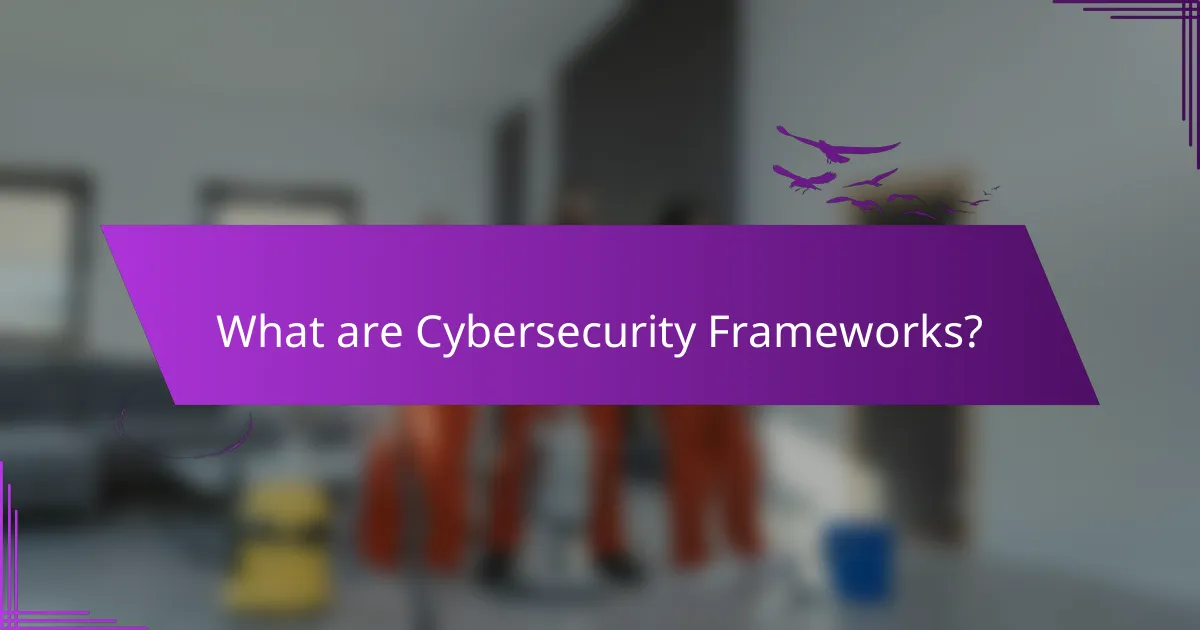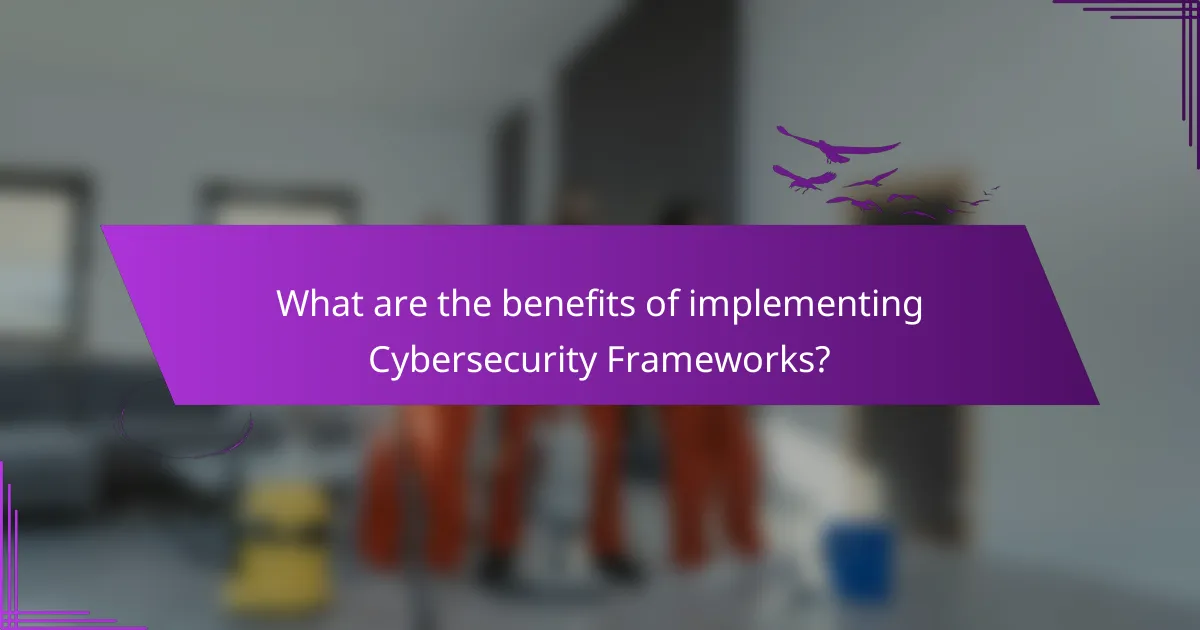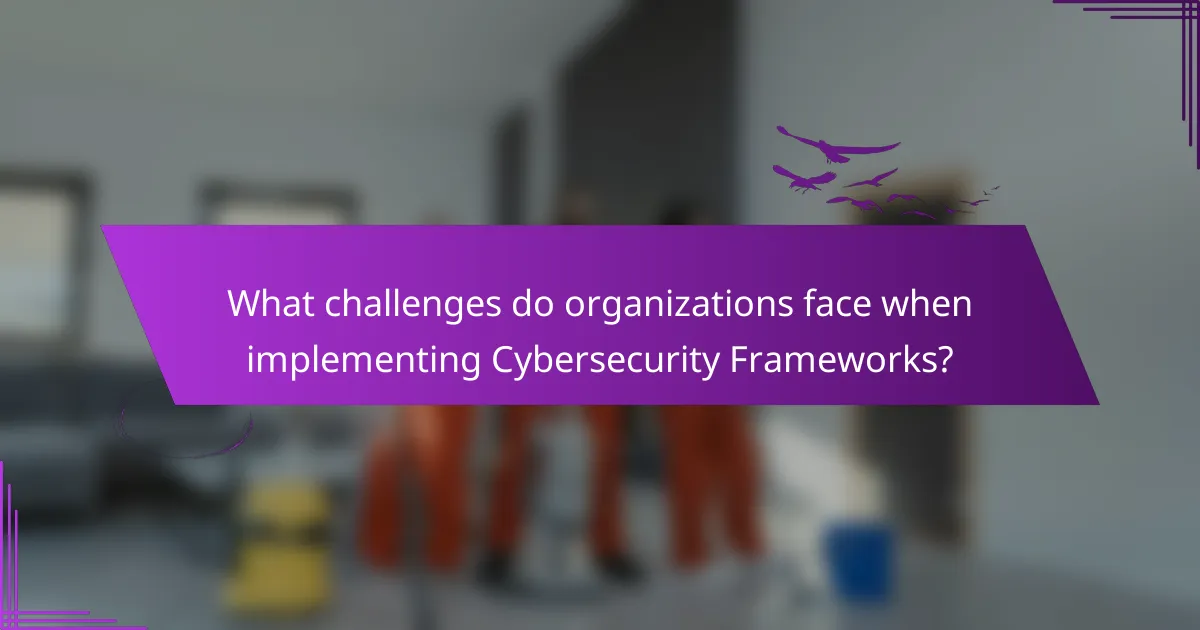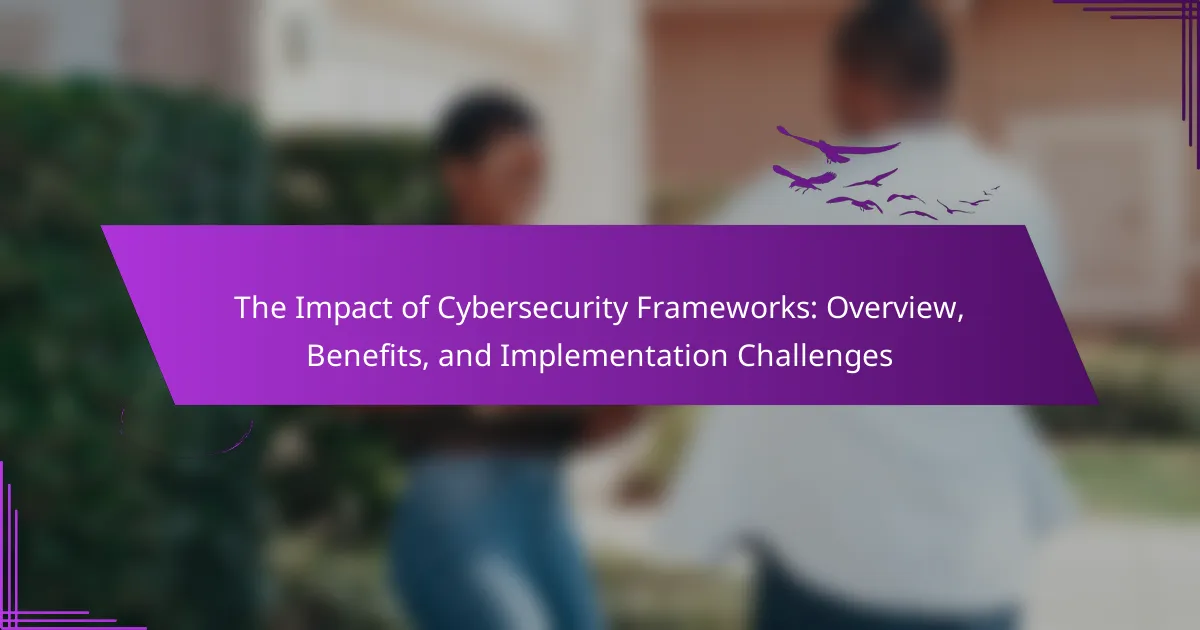
What are Cybersecurity Frameworks?
Cybersecurity frameworks are structured guidelines that organizations use to manage and reduce cybersecurity risks. They provide a comprehensive approach to identifying, assessing, and mitigating threats. Frameworks like the NIST Cybersecurity Framework and ISO/IEC 27001 are widely recognized. These frameworks help organizations establish policies and procedures for protecting sensitive data. They also assist in compliance with regulatory requirements. By following these frameworks, organizations can improve their overall security posture. Research shows that companies using such frameworks experience fewer security incidents. This demonstrates their effectiveness in enhancing cybersecurity measures.
How do Cybersecurity Frameworks function?
Cybersecurity frameworks function by providing structured guidelines for managing and reducing cybersecurity risks. They establish a common language for organizations to assess their security posture. Frameworks like NIST Cybersecurity Framework outline key areas such as identify, protect, detect, respond, and recover. Each area includes specific tasks and outcomes to achieve effective cybersecurity management. By following these guidelines, organizations can prioritize their security efforts based on risk assessments. This structured approach enhances overall security and compliance with regulations. Studies show that organizations using frameworks report improved risk management and incident response capabilities.
What are the key components of Cybersecurity Frameworks?
The key components of Cybersecurity Frameworks include identification, protection, detection, response, and recovery. Identification involves asset management and risk assessment. Protection focuses on implementing safeguards to ensure critical infrastructure services. Detection encompasses monitoring systems to identify cybersecurity events. Response outlines the processes for managing incidents and mitigating impact. Recovery ensures timely restoration of services and operations after a cybersecurity incident. These components collectively form a comprehensive approach to managing cybersecurity risks effectively.
How do these components interact within a Cybersecurity Framework?
Components within a Cybersecurity Framework interact through a structured approach to risk management. The framework consists of five core functions: Identify, Protect, Detect, Respond, and Recover. Each function supports and informs the others, creating a continuous cycle of improvement. For example, the Identify function establishes an understanding of cybersecurity risks. This understanding informs the Protect function, which implements safeguards. The Detect function monitors for security events, providing data that influences the Respond function. The Respond function activates incident response plans, which then inform the Recover function to restore services. This interaction ensures a comprehensive approach to cybersecurity, enhancing an organization’s resilience against threats.
Why are Cybersecurity Frameworks important?
Cybersecurity frameworks are important because they provide structured guidelines for managing cybersecurity risks. These frameworks help organizations identify, assess, and mitigate threats effectively. They establish a common language for stakeholders, enhancing communication about security practices. Frameworks also promote best practices and compliance with regulations, reducing legal risks. For example, the NIST Cybersecurity Framework is widely adopted and offers a comprehensive approach to managing cyber risks. Organizations using it report improved security postures and incident response capabilities. By following established frameworks, companies can allocate resources more efficiently and prioritize their cybersecurity efforts.
What risks do Cybersecurity Frameworks help mitigate?
Cybersecurity frameworks help mitigate risks such as data breaches, unauthorized access, and malware attacks. They provide structured guidelines for organizations to protect sensitive information. By implementing these frameworks, companies can reduce vulnerabilities in their systems. This leads to enhanced incident response capabilities. Additionally, frameworks address compliance with regulations like GDPR and HIPAA. They also help in identifying and managing third-party risks. Overall, cybersecurity frameworks promote a proactive security posture. This can lead to significant cost savings associated with potential breaches.
How do Cybersecurity Frameworks enhance organizational resilience?
Cybersecurity frameworks enhance organizational resilience by providing structured guidelines for risk management. These frameworks help organizations identify, assess, and mitigate cybersecurity risks effectively. They establish a common language for stakeholders, improving communication about security practices. By following these frameworks, organizations can better prepare for, respond to, and recover from cyber incidents. For instance, the NIST Cybersecurity Framework emphasizes continuous improvement and adaptation to emerging threats. This proactive approach enables organizations to strengthen their defenses over time. Additionally, organizations that implement these frameworks often experience reduced downtime during incidents. Studies show that companies using established frameworks can recover from breaches faster and with less financial impact.

What are the benefits of implementing Cybersecurity Frameworks?
Implementing Cybersecurity Frameworks enhances an organization’s security posture. These frameworks provide structured guidelines for identifying, assessing, and managing cybersecurity risks. They help organizations comply with regulatory requirements, reducing legal liabilities. Frameworks also facilitate communication about security practices among stakeholders. By standardizing security measures, they improve incident response and recovery processes. Research shows that organizations using frameworks experience fewer security breaches. For example, the NIST Cybersecurity Framework has been adopted by thousands of organizations, leading to measurable improvements in security outcomes.
How do Cybersecurity Frameworks improve compliance?
Cybersecurity frameworks improve compliance by providing structured guidelines and best practices. These frameworks help organizations align their security measures with regulatory requirements. They facilitate risk management by identifying vulnerabilities and establishing controls. Implementing these frameworks can lead to standardized processes across different sectors. This standardization simplifies audits and assessments for compliance verification. Research shows that organizations using frameworks like NIST or ISO 27001 report higher compliance rates. In fact, a 2021 study by Ponemon Institute found that 64% of organizations using cybersecurity frameworks improved their compliance posture.
What specific regulations do Cybersecurity Frameworks address?
Cybersecurity frameworks address specific regulations such as the Health Insurance Portability and Accountability Act (HIPAA), the Federal Information Security Management Act (FISMA), and the Payment Card Industry Data Security Standard (PCI DSS). These regulations establish requirements for protecting sensitive data and ensuring privacy. For example, HIPAA mandates safeguards for health data, while FISMA requires federal agencies to secure information systems. PCI DSS focuses on securing credit card transactions to prevent fraud. Compliance with these regulations is essential for organizations to mitigate risks and protect data integrity.
How can organizations demonstrate compliance through Cybersecurity Frameworks?
Organizations can demonstrate compliance through Cybersecurity Frameworks by implementing standardized practices and controls. These frameworks, such as NIST and ISO/IEC 27001, provide guidelines for managing cybersecurity risks. By following these guidelines, organizations can align their security measures with regulatory requirements. This alignment helps in fulfilling legal and industry compliance obligations. Regular assessments and audits against these frameworks can provide evidence of compliance. Additionally, documenting policies and procedures related to the framework enhances transparency. Organizations can also leverage third-party certifications to validate their adherence to these frameworks. This approach not only proves compliance but also strengthens overall security posture.
What cost advantages do Cybersecurity Frameworks provide?
Cybersecurity frameworks provide significant cost advantages by reducing the likelihood of security breaches. These frameworks standardize security practices, which can lower implementation costs. Organizations that adopt these frameworks often see a decrease in incident response costs. According to a study by IBM, the average cost of a data breach is $3.86 million. Implementing a cybersecurity framework can mitigate these costs by up to 50%. Additionally, frameworks help in compliance with regulations, avoiding potential fines. This proactive approach leads to long-term savings on insurance premiums and legal expenses. Overall, the structured nature of cybersecurity frameworks enhances resource allocation and operational efficiency.
How can Cybersecurity Frameworks reduce incident response costs?
Cybersecurity frameworks can reduce incident response costs by providing structured guidelines for risk management. These frameworks help organizations identify vulnerabilities and prioritize security measures. By establishing a clear response plan, organizations can minimize the time and resources spent on incidents. For example, the National Institute of Standards and Technology (NIST) Cybersecurity Framework emphasizes risk assessment and incident response planning. Research indicates that organizations using such frameworks can decrease response costs by up to 30%. This reduction is due to improved efficiency and preparedness during incidents.
What long-term savings can organizations expect from Cybersecurity Frameworks?
Organizations can expect significant long-term savings from implementing Cybersecurity Frameworks. These frameworks reduce the likelihood of data breaches and cyber incidents. A study by IBM found that the average cost of a data breach is $3.86 million. By adopting robust cybersecurity measures, organizations can mitigate these costs. Additionally, Cybersecurity Frameworks enhance operational efficiency. They streamline compliance with regulations, reducing potential fines. Furthermore, organizations can save on recovery costs after an incident. Investing in these frameworks leads to improved risk management and lower insurance premiums. Overall, the financial benefits are substantial and justify the initial investment.

What challenges do organizations face when implementing Cybersecurity Frameworks?
Organizations face several challenges when implementing Cybersecurity Frameworks. One major challenge is the lack of skilled personnel. According to a 2021 report by (ISC)², there is a global shortage of 3.12 million cybersecurity professionals. This shortage hampers the ability to effectively implement and manage frameworks.
Another challenge is the integration with existing systems. Many organizations have legacy systems that are not compatible with modern frameworks. This can lead to increased costs and complexity during implementation.
Compliance with regulations also poses a challenge. Organizations must navigate various legal requirements related to data protection and cybersecurity. Failure to comply can result in significant penalties.
Additionally, there is often resistance to change within organizations. Employees may be hesitant to adopt new processes or technologies. This resistance can slow down the implementation process.
Finally, measuring the effectiveness of the framework can be difficult. Organizations need to establish metrics to assess the framework’s performance. Without clear metrics, it is challenging to determine if the framework is achieving its intended goals.
What are the common obstacles to adopting Cybersecurity Frameworks?
Common obstacles to adopting Cybersecurity Frameworks include lack of awareness, resource constraints, and organizational resistance. Many organizations are unaware of existing frameworks or their benefits. Limited budgets can hinder the implementation of necessary technologies and training. Additionally, employees may resist changes to established processes. Complexity of frameworks can also deter adoption. Some frameworks require significant time and effort to integrate effectively. Regulatory compliance can add further challenges, as organizations must align frameworks with specific legal requirements. These factors collectively impede the widespread adoption of Cybersecurity Frameworks.
How can organizations overcome resistance to change?
Organizations can overcome resistance to change by fostering open communication. Transparent dialogue helps address concerns directly. Engaging employees in the change process increases buy-in. Providing training and resources supports adaptation to new practices. Leadership should model desired behaviors to influence acceptance. Establishing clear benefits of change demonstrates its value. Recognizing and rewarding adaptability encourages a positive culture. Research shows that organizations with effective change management strategies see a 70% success rate in initiatives.
What skills gaps exist in relation to Cybersecurity Framework implementation?
Skills gaps in Cybersecurity Framework implementation include a lack of understanding of the frameworks themselves. Many professionals are unfamiliar with the specific requirements of frameworks like NIST or ISO 27001. Additionally, there is often insufficient expertise in risk management processes. Many organizations struggle with identifying and assessing risks effectively. Another gap is the shortage of trained personnel in security controls and compliance measures. This leads to ineffective implementation of necessary security protocols. Furthermore, there is a lack of skills in incident response and recovery planning. This can hinder an organization’s ability to respond to security breaches. Finally, continuous training and awareness programs are often inadequate. This results in employees not being up-to-date with the latest cybersecurity practices.
How does organizational culture impact the implementation of Cybersecurity Frameworks?
Organizational culture significantly influences the implementation of Cybersecurity Frameworks. A strong security culture fosters employee engagement and compliance with security policies. When employees prioritize security, frameworks are more likely to be effectively adopted. Conversely, a weak culture may lead to resistance, undermining security initiatives. Research shows that organizations with a positive security culture experience fewer breaches. For example, a 2020 study by the Ponemon Institute found that organizations with robust security cultures had 30% fewer incidents. Therefore, aligning organizational culture with cybersecurity goals is essential for successful framework implementation.
What role does leadership play in successful implementation?
Leadership is crucial for successful implementation of cybersecurity frameworks. Effective leaders establish a clear vision and direction for the organization. They foster a culture of security awareness among employees. Leaders also allocate necessary resources for implementation. They ensure alignment between cybersecurity goals and business objectives. Communication from leadership reinforces the importance of compliance and best practices. Studies show that organizations with strong leadership commitment experience fewer security breaches. For instance, according to the Ponemon Institute, companies with engaged leadership report a 40% reduction in security incidents. Thus, leadership significantly influences the success of implementing cybersecurity frameworks.
How can organizations foster a culture of cybersecurity awareness?
Organizations can foster a culture of cybersecurity awareness by implementing comprehensive training programs. Regular training sessions educate employees about potential threats and safe practices. Organizations should also promote open communication regarding cybersecurity issues. Encouraging reporting of suspicious activities helps identify risks early. Leadership must demonstrate a commitment to cybersecurity through policies and resources. Incentives for safe behavior can motivate employees to prioritize cybersecurity. Regular assessments and updates of security policies ensure relevance. According to a study by the Ponemon Institute, organizations with a strong security culture experience 50% fewer security incidents.
What best practices should organizations follow when implementing Cybersecurity Frameworks?
Organizations should follow structured approaches when implementing Cybersecurity Frameworks. First, they should assess their current cybersecurity posture through comprehensive risk assessments. This helps identify vulnerabilities and areas needing improvement. Next, organizations must align their framework with industry standards, such as NIST or ISO, to ensure compliance and best practices.
Training employees on cybersecurity awareness is crucial. A well-informed workforce can significantly reduce risks associated with human error. Regularly updating and reviewing cybersecurity policies is also essential. This ensures that the framework adapts to emerging threats and changes in the organizational environment.
Additionally, organizations should implement continuous monitoring and incident response plans. These practices help detect and respond to threats in real time. Collaboration with stakeholders, including IT and legal teams, fosters a unified approach to cybersecurity. Finally, organizations should document their processes and maintain clear communication to ensure accountability and transparency.
How can organizations effectively assess their cybersecurity needs?
Organizations can effectively assess their cybersecurity needs by conducting a comprehensive risk assessment. This involves identifying critical assets, evaluating potential threats, and analyzing vulnerabilities. Organizations should also review existing security controls and policies. They can utilize frameworks such as NIST Cybersecurity Framework or ISO/IEC 27001 for structured guidance. Engaging stakeholders across departments enhances the assessment process. Regularly updating the assessment ensures that evolving threats are addressed. According to a 2021 report by Cybersecurity & Infrastructure Security Agency, organizations that conduct regular assessments significantly reduce their risk exposure.
What steps should organizations take to ensure a smooth implementation process?
Organizations should follow a structured approach to ensure a smooth implementation process. First, they must define clear objectives for the implementation. This involves understanding the specific goals related to cybersecurity frameworks. Next, organizations should assess their current cybersecurity posture. This includes identifying existing vulnerabilities and resources.
After assessment, it is crucial to engage stakeholders throughout the process. Stakeholder involvement fosters collaboration and buy-in, which is essential for success. Organizations should also develop a detailed implementation plan. This plan should outline timelines, responsibilities, and required resources.
Training employees on new processes and tools is another vital step. Well-informed staff can effectively utilize the cybersecurity framework. Continuous monitoring and feedback mechanisms should be established to address any challenges that arise during implementation.
Finally, organizations should conduct a post-implementation review. This review helps identify lessons learned and areas for improvement. By following these steps, organizations can facilitate a smoother implementation of cybersecurity frameworks.
Cybersecurity frameworks are structured guidelines that organizations utilize to manage and mitigate cybersecurity risks effectively. This article provides an overview of various frameworks, such as the NIST Cybersecurity Framework and ISO/IEC 27001, highlighting their importance in enhancing security posture, ensuring compliance with regulations, and reducing incident response costs. Key components of these frameworks include identification, protection, detection, response, and recovery, which interact to create a comprehensive risk management approach. The article also addresses common challenges organizations face during implementation, such as skills gaps and resistance to change, while outlining best practices for successful adoption.
